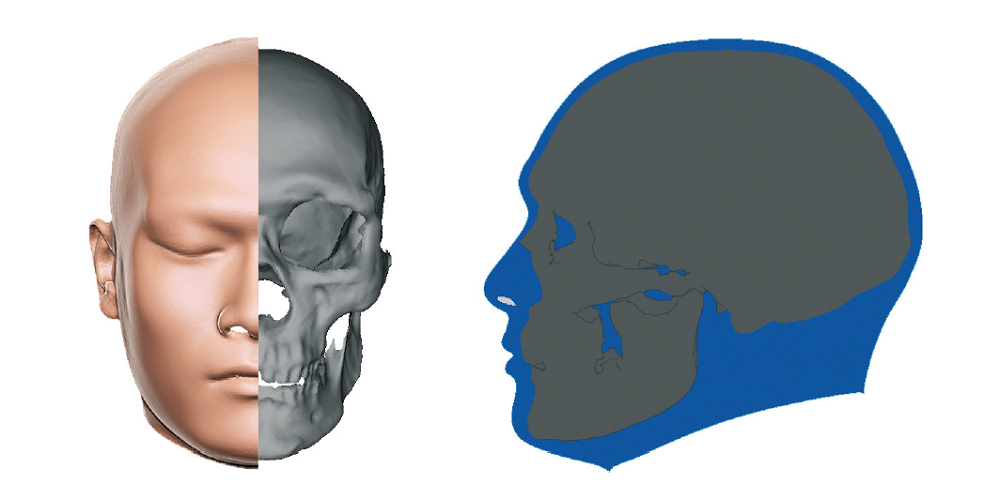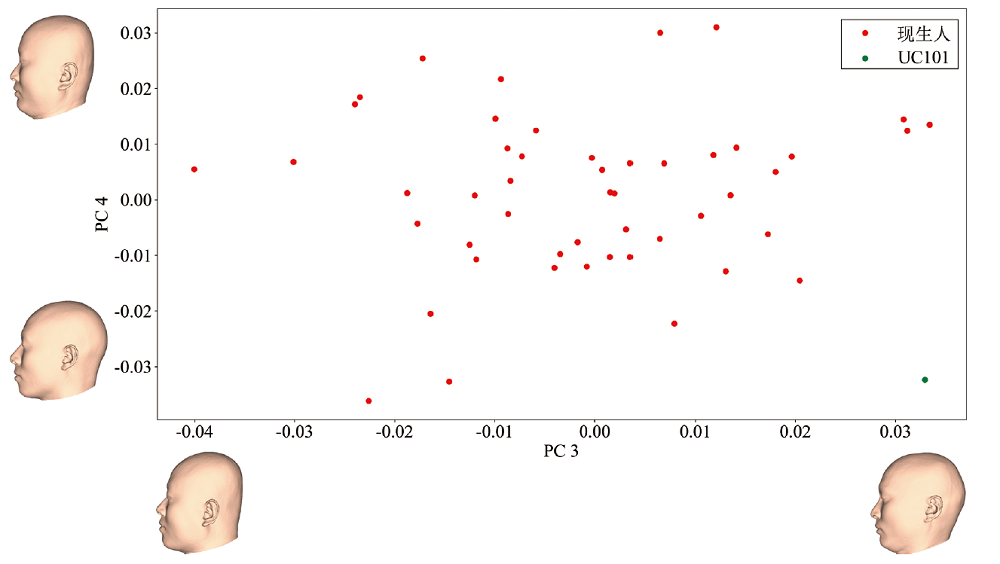| [1] |
刘武, 何嘉宁, 吴秀杰, 等. 山顶洞人与现代华北人头骨非测量性特征比较及中国更新世晚期人类演化的一些问题[J]. 人类学学报, 2006,25(1):26-41
|
| [2] |
Li F, Bae CJ, Ramsey CB, et al. Re-dating Zhoukoudian Upper Cave, northern China and its regional significance[J]. Journal of Human Evolution, 2018,121:170-177
URL
pmid: 29778246
|
| [3] |
Wilkinson C. Forensic Facial Reconstruction[M]. Cambridge University Press, Cambridge, 2004.
|
| [4] |
Lee WJ, Yoon AY, Mi KS, et al. The archaeological contribution of forensic craniofacial reconstruction to a portrait drawing of a Korean historical figure[J]. Journal of Archaeological Science, 2014,49:228-236.
doi: 10.1016/j.jas.2014.05.022
URL
|
| [5] |
Stephan CN, Caple JM, Guyomarc’h P, et al. An overview of the latest developments in facial imaging[J]. Forensic sciences research, 2019,4(1):10-28
doi: 10.1080/20961790.2018.1519892
URL
pmid: 30915414
|
| [6] |
周明全, 耿国华, 李康, 等. 颅面形态信息学[M]. 北京: 科学出版社, 2016
|
| [7] |
Claes P, Vandermeulen D, De Greef S, et al. Computerized craniofacial reconstruction: conceptual framework and review[J]. Forensic Science International, 2010,201(1-3):138-145
doi: 10.1016/j.forsciint.2010.03.008
URL
pmid: 20359837
|
| [8] |
Vanezis P, Vanezis M, McCombe G, et al. Facial reconstruction using 3-D computer graphics[J]. Forensic Science International, 2000,108(2):81-95
doi: 10.1016/s0379-0738(99)00026-2
URL
pmid: 10722195
|
| [9] |
税午阳, 周明全, 纪元, 等. 面部软组织厚度测量及其在面貌复原中的应用[J]. 人类学学报, 2013,32(3):345-353
|
| [10] |
Quatrehomme G, Cotin S, Subsol G, et al. A fully three-dimensional method for facial reconstruction based on deformable models[J]. Journal of Forensic Sciences, 1997,42(4):649-652
URL
pmid: 9243826
|
| [11] |
Turner WD, Brown RE, Kelliher TP, et al. A novel method of automated skull registration for forensic facial approximation. Forensic Science International, 2005,154(2-3):149-158
|
| [12] |
Deng QQ, Zhou MQ, Shui W, et al. A novel skull registration based on global and local deformations for craniofacial reconstruction[J]. Forensic Science International, 2011,208(1-3):95-102
doi: 10.1016/j.forsciint.2010.11.011
URL
|
| [13] |
Shui WY, Zhou MQ, Deng QQ, et al. Densely Calculated Facial Soft Tissue Thickness for Craniofacial Reconstruction in Chinese Adults[J]. Forensic Science International, 2016, 266:573.e1-573.e12
doi: 10.1016/j.forsciint.2016.07.017
URL
|
| [14] |
Gietzen T, Brylka R, Achenbach J, et al. A method for automatic forensic facial reconstruction based on dense statistics of soft tissue thickness[J]. PloS one, 2019. 14(1):e0210257
doi: 10.1371/journal.pone.0210257
URL
pmid: 30673719
|
| [15] |
Kähler K, Haber J, Seidel H. Reanimating the dead: reconstruction of expressive faces from skull data[J]. ACM Transactions on Graphics, 2003,22(3):554-561
doi: 10.1145/882262.882307
URL
|
| [16] |
Lee WJ, Wilkinson C, Hwang HS, et al. Correlation Between Average Tissue Depth Data and Quantitative Accuracy of Forensic Craniofacial Reconstructions Measured by Geometric Surface Comparison Method[J]. Journal of Forensic Sciences, 60(3):572-580
doi: 10.1111/1556-4029.12726
URL
pmid: 25739646
|
| [17] |
Wilkinson C, Rynn C, Peters H, et al. A blind accuracy assessment of computer-modeled forensic facial reconstruction using computed tomography data from live subjects[J]. Forensic Science, Medicine and Pathology, 2006,2(3):179-187
doi: 10.1007/s12024-006-0007-9
URL
|
| [18] |
Deng QQ, Zhou MQ, Wu ZK, et al. A regional method for craniofacial reconstruction based on coordinate adjustments and a new fusion strategy[J]. Forensic Science International, 2016,259:19-31
doi: 10.1016/j.forsciint.2015.10.033
URL
pmid: 26773218
|
| [19] |
Paysan P, Lüthi M, Albrecht T, et al. Face Reconstruction from Skull Shapes and Physical Attributes[C]. Lecture Notes in Computer Science, Pattern Recognition, Springer, 2009: 232-241
|
| [20] |
Berar M, Tilotta F M, Glaunès J A, et al. Craniofacial reconstruction as a prediction problem using a Latent Root Regression model[J]. Forensic Science International, 2011,210(1-3):228-236
doi: 10.1016/j.forsciint.2011.03.010
URL
|
| [21] |
税午阳, 吴秀杰. 奇和洞古人类头骨面貌的三维虚拟复原[J]. 科学通报, 2018,63(8):745-754
|
| [22] |
Sero D, Zaidi A, Li J, et al. Facial recognition from DNA using face-to-DNA classifiers[J]. Nature Communications. 2019,10:2557
doi: 10.1038/s41467-019-10617-y
URL
pmid: 31186421
|
| [23] |
吴新智. 周口店山顶洞人化石的研究[J]. 古脊椎动物与古人类, 1961,3(3):181-211
|
| [24] |
Shui WY, Zhou MQ, Maddock S, et al. A computerized craniofacial reconstruction method for an unidentified skull based on statistical shape models[J]. Multimedia Tools and Applications, 2020,79:25589-25611
doi: 10.1007/s11042-020-09189-7
URL
|
| [25] |
Martin R. Lehrbuch der Anthropologie in systematischer Darstellung[M]. G. Fischer, Stuttgart, 1928
|
| [26] |
Wiley DF, Amenta N, Alcantara DA, et al. Evolutionary morphing[C]. IEEE Visualization (VIS’05), 2005: 431-438
|
| [27] |
Shui WY, Zhou MQ, Maddock S, et al. A PCA-Based method for determining craniofacial relationship and sexual dimorphism of facial shapes[J]. Computers in Biology and Medicine. 2017,90:33-49
doi: 10.1016/j.compbiomed.2017.08.023
URL
pmid: 28918063
|
| [28] |
Shui W, Zhou M, Wu Z, et al. An improved algorithm for craniofacial reconstruction based on landmarks registration[C]. IEEE International Conference on Computer Application and System Modeling (ICCASM), 2010: 498-502
|
| [29] |
税午阳, 周明全, 武仲科, 等. 数据配准的颅骨面貌复原方法[J]. 计算机辅助设计与图形学学报, 2011,23(4):607-614
|
| [30] |
Amberg B, Romdhani S, Vetter T. Optimal step nonrigid ICP algorithms for surface registration[C]. IEEE Conference on Computer Vision and Pattern Recognition, 2007: 1-8
|
| [31] |
Wilkinson C. Facial reconstruction—anatomical art or artistic anatomy?[J]. Journal of Anatomy, 2010,216:235-250
doi: 10.1111/j.1469-7580.2009.01182.x
URL
pmid: 20447245
|
| [32] |
Short LJ, Khambay B, Ayoub A, et al. Validation of a computer modelled forensic facial reconstruction technique using CT data from live subjects: a pilot study[J]. Forensic Science International, 2014, 237: 147.e1-147.e8
doi: 10.1016/j.forsciint.2013.12.042
URL
|
| [33] |
Miranda GE, Wilkinson C, Roughley M, et al. Assessment of accuracy and recognition of three-dimensional computerized forensic craniofacial reconstruction[J]. Plos One, 2018,13(5):e0196770
URL
pmid: 29718983
|
| [34] |
Cunningham DL and Jantz RL. The morphometric relationship of Upper Cave 101 and 103 to modern Homo sapiens[J]. Journal of Human Evolution, 2003,45(1):1-18
doi: 10.1016/S0047-2484(03)00064-2
URL
|
| [35] |
Kustar A. The facial restoration of Antal Simon, a Hungarian priest-teacher of the 19th c[J]. HOMO-Journal of Comparative Human Biology, 2004,55(1-2):77-90
doi: 10.1016/j.jchb.2004.01.002
URL
|
| [36] |
Benazzi S, Fantini M, Crescenzio FD, et al. The face of the poet Dante Alighieri reconstructed by virtual modelling and forensic anthropology techniques[J]. Journal of Archaeological Science, 2009,36(2):278-283
doi: 10.1016/j.jas.2008.09.006
URL
|
| [37] |
Benazzi S, Bertelli P, Lippi B, et al. Virtual anthropology and forensic arts: the facial reconstruction of Ferrante Gonzaga[J]. Journal of Archaeological Science, 2010,37(7):1572-1578
doi: 10.1016/j.jas.2010.01.018
URL
|
| [38] |
张建军. 谈谈我国古人类化石面貌复原像[J]. 大自然, 2011,3:24-26
|
| [39] |
张建军. 从北京猿人到南京猿人的面貌复原[J]. 化石, 2015,2:66-69
|
| [40] |
Vanezis P, Blowes RW, Linney AD, et al. Application of 3-D computer graphics for facial reconstruction and comparison with sculpting techniques[J]. Forensic Science International, 1989,42(1-2):69-84
doi: 10.1016/0379-0738(89)90200-4
URL
pmid: 2759524
|
| [41] |
Pei Y, Zha H, Yuan Z. The Craniofacial Reconstruction from the Local Structural Diversity of Skulls[J]. Computer Graphics Forum, 2008,27(7):1711-1718
doi: 10.1111/cgf.2008.27.issue-7
URL
|
| [42] |
Stephan CN and Preisler R. In vivo facial soft tissue thicknesses of adult Australians[J]. Forensic Science International, 2018, 282: 220.e1-e12
doi: 10.1016/j.forsciint.2017.11.014
URL
|
| [43] |
Cavanagh D and Steyn M. Facial reconstruction: soft tissue thickness values for South African black females[J]. Forensic Science International, 2011,206(1-3):215 e1-e7
|
| [44] |
Shrimpton S, Daniels K, De Greef S, et al. A spatially-dense regression study of facial form and tissue depth: towards an interactive tool for craniofacial reconstruction[J]. Forensic Science International, 2014,234:103-110
doi: 10.1016/j.forsciint.2013.10.021
URL
|
| [45] |
Vandermeulen D, Claes P, Loeckx D, et al. Computerized craniofacial reconstruction using CT-derived implicit surface representations[J]. Forensic Science International, 2006,159(S):S164-S174
doi: 10.1016/j.forsciint.2006.02.036
URL
|
| [46] |
Bulut O, Jessica L C Y, Koca F, et al. Comparison of three-dimensional facial morphology between upright and supine positions employing three-dimensional scanner from live subjects[J]. Legal Medicine, 2017,27:32-37
doi: 10.1016/j.legalmed.2017.06.002
URL
pmid: 28675828
|










